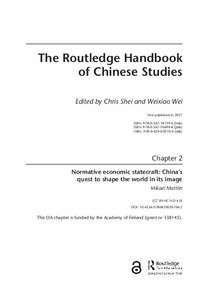Normative economic statecraft: China’s quest to shape the world in its image
Mattlin Mikael
https://urn.fi/URN:NBN:fi-fe2021093048590
Kuvaus
Tiivistelmä
Arguably, two of the greatest questions in 21st-century world politics
are how the preexisting institutions of the international system will be
able to accommodate a rapidly rising China, and how China is going to
wield its expanding global power and influence. Unsurprisingly, these
have also been two of the hottest topics in Chinese studies over the
past decade. Until the global financial crisis in 2008 and the Chinese
leadership change in 2012, China was commonly seen as a nonrevisionist
power gradually integrating into the Pax Americana system, while
securing its own national interests. Since then, views of China’s rise
have undergone a transformation. Today, China’s actions on the global
stage invite more wary commentary, even apprehension. Yet, compared both
to former and current Great Powers, what stands out about China’s use
of power and influence is neither its militarism nor its ‘soft power’.
China wields its power most actively, and arguably also most
effectively, by using the purse, i.e., through trade, investment, and
lending. China’s signature foreign policy project, the Belt and Road
Initiative (BRI), is a case in point. This chapter provides an overview
of state-of-the-art research revolving around China’s use of economic
and financial means to serve foreign policy objectives with normative
implications, defined here as normative economic statecraft. The
chapter’s overview of China’s use of economic statecraft reveals its
breadth and diversity. China also indirectly challenges existing
international norms of economic governance by its alternative modus
operandi. As China does not always proclaim its challenge to existing
norms, this paper suggests an analytical distinction between stated and
concealed normative objectives. Much of China’s challenge to global
economic governance norms is concealed. Research on China has
revitalized old debates on economic statecraft and geoeconomics, and
reoriented their focus from economic coercion (e.g., sanctions) to
economic inducements, and alternative institutions and norms. This
subfield of China studies thus has a scholarly impact beyond the area
studies specialization.
Kokoelmat
- Rinnakkaistallenteet [19207]
